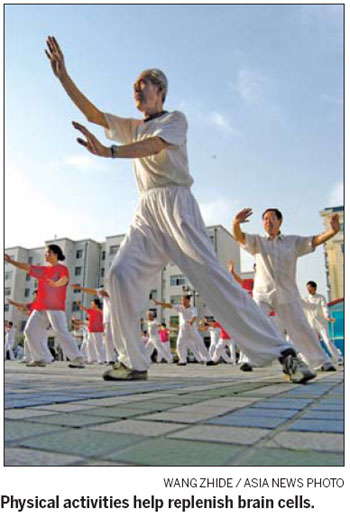Possible to kick-start inert brain cells, says study
(China Daily)
Updated: 2010-06-02 09:35
 |
Large Medium Small |

Physical exercise helps to regenerate brain cells that are lost due to aging, according to a study by German researchers.
The scientists believe that the discovery may lead to new ways of tackling age-related memory loss, the effects of brain injuries or Alzheimer's disease.
Until now, the conventional wisdom has been that brain cells die during the course of a person's life and cannot be replaced.
But it is now known that at least some nerve cells can be replenished in the hippocampus, the brain region that plays a key role in learning and memory.
However, a large proportion of the stem cells that give rise to new neurons remain dormant in adults. The new research in mice shows that these cells can be "kick-started" into action by physical activity and epileptic seizures.
The scientists found that physically active mice developed more newborn hippocampal neurons than inactive animals.
"Running promotes the formation of new neurons," says study leader Dr Verdon Taylor of the Max Planck Institute of Immunobiology in Freiburg, Germany. Abnormal brain activity, as occurs during epileptic seizures, also appeared to trigger neuron generation. Excessive formation of new nerve cells is thought to play a role in epilepsy, says Taylor, whose research appeared in the journal Cell Stem Cell.
The scientists identified different populations of neuronal stem cells in the brains of mice, some of which were active and others dormant.
"In young mice, the stem cells divide four times more frequently than in older animals," Taylor says. "However, the number of cells in older animals is only slightly lower. Therefore, neuronal stem cells do not disappear with age but are kept in reserve."
In physically active mice, some previously dormant stem cells were seen to come back to life and start to divide. Other sporadically dormant stem cells were unaffected by physical activity, but awakened by epileptic seizures.
A similar pattern of active and inactive stem cells probably occurs in the human brain, the scientists say. It was likely that dormant stem cells could be reactivated in humans in the same way they were in mice.